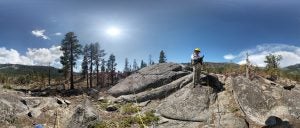The California Prescribed Fire Monitoring Program (CPFMP) is a collaboration between CALFIRE and the University of California, Davis to develop a long-term monitoring program to measure prescribed fire effects on fuels, botany, forest structure, carbon storage, and the resultant impacts to air quality. Permanent monitoring plots are established in a variety of ecosystems where fire is applied to meet a range of management objectives. Field crews collect pre- and post-fire data to pair with fire behavior and weather observations made during the burn. Plots are then remeasured over time to quantify long-term fire effects, such as botanical response and tree mortality. The program is designed to evaluate the effectiveness of prescribed fire beyond just the number of acres burned and to provide a scientific foundation to guide air and land decision-making regarding the use of prescribed fire. Monitoring data is also used to aid communication to the public, landowners, and the legislature the benefits of prescribed fire as a management tool. Where not meeting objectives, or having unintended impacts, monitoring can help to adapt management strategies and improve current best management practices.
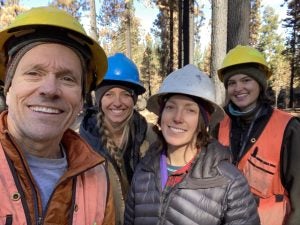
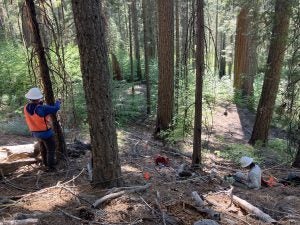
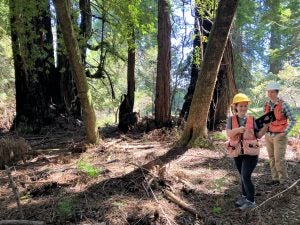
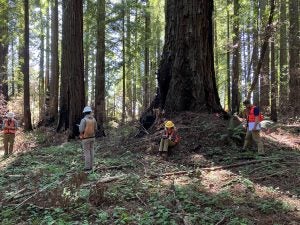
The CPFMP encompasses over 38 sites (995 plots)) across the state on lands managed by more than 15 entities, including federal, state, and local agencies, universities, NGOs, and private landowners. These data can play an essential role in building credibility around prescribed fire capacity and efficacy for large-scale managed fire programs.
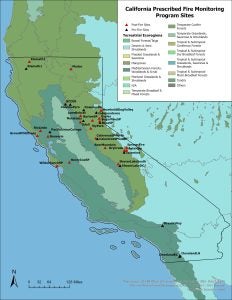
Goals and Objectives
The main goals of the CPFMP are to:
• Provide the scientific foundation for best practices in prescribed fire planning and implementation in California.
• Develop a monitoring framework that supports the adaptive management cycle and provides field-level feedback to strategic efforts that safeguard carbon stocks and other ecosystem services, promote ecosystem resilience, and enhance adaptive capacity in California ecosystems.
The main objectives:
1. Monitor prescribed fire treatment effectiveness, measured as reduction of fuel loading and continuity, and reductions in flame length and spread rate.
2. Monitor prescribed fire treatment effects, measured as changes in aboveground carbon, tree mortality and damage, soil surface conditions, understory plant species, and other variables as determined. Continue monitoring of selected sites for a number of years after treatment.
3. Carry out inventory and monitoring of areas that have been previously prescribe burned > 2 times in the recent past, in order to develop a database of ecosystem conditions, effects, and dynamics that result from the institution of frequent burning.
4. Carry out project reporting and outreach throughout the year, including: annual reports, stakeholder reporting, peer-reviewed literature, field and office workshops with fire and vegetation managers, webinars and lectures, and interactions with prescribed fire practitioners.
Accomplishments and Outcomes
Since 2019:
• Monitoring completed or underway at 35 project sites, in 150 burn units on more than 10,000 total acres, in several California counties
• Collaborative monitoring with multiple partner organizations, including:
CALFIRE
US Forest Service
California State Parks
The Nature Conservancy
Southern California Edison Company
Eldorado Irrigation District
Fire Forward
Numerous Resource Conservation Districts
Publications
York, R., Restaino J., Levine J., Russel K. 2021. Opportunities for winter prescribed burning in mixed conifer plantations of the Sierra Nevada. Fire Ecology 17:33
Safford, H.D., Grupenhoff, A., Williams, J.N., Putz, T., Restaino, J. 2023. Measuring success: Monitoring program assesses benefits of prescribed burning. Wildfire Magazine Qrtr 1: 14-23
Williams, J.N., Quinn-Davidson, L., Safford, H.D., Grupenhoff, A., Middleton, B.E., Restaino, J., Smith, E., Adlam, C., Rivera-Huerta, H. 2023. Overcoming barriers to prescribed fire in the North American Mediterranean Climate Zone. Frontiers in Ecology and the Environment: doi:10.1002/fee.2687
Jonko, A., A. Atchley, T. Beaty, J. Oliveto, M. Battaglia, B. Collins, M. Dickinson, M. Gallagher, D. Godwin, J. Kupfer, J. K. Hiers, C. Hoffman, M. Norris, M. North, R. Parsons, J. Restaino, C. Seig, N. Skowronski, K. Yedinak. 2024. How will future climate change impact prescribed fire operations across the contiguous United States? Climate and Atmospheric Science. In Review.
Fossum C, Collins B, Stephens C, Lydersen J, Restaino J, Katuna T, and Stephens S. 2024. 22-year trends in prescribed fire weather windows in California. Agricultural and Forest Meteorology. In prep
Grupenhoff, A., et al. First entry prescribed fire has greatest effects on surface fuels but limited effect in altering forest structure. (In prep.)
Reports
Safford, H.D., A. Grupenhoff, J.N. Williams. 2021. California Prescribed Fire Monitoring Program: Report on the 2019 Springs Fire Resource Benefit Burn, Inyo National Forest.
Presentations and webinars
Restaino, J. 2019-2023. Prescribed fire Research and Monitoring. Invited talk. California Air Pollution Control Officers Association: Prescribed Fire Smoke Management Training, Various Locations.
Restaino, J. April 2020. Introducing the California Prescribed Fire Monitoring Program. IAWF International Smoke Symposium. Davis, CA.
Restaino, J. and Williams J. October 2020. The California Prescribed Fire Monitoring Program. 2020 Natural Areas Association Conference. Reno, NV.
Safford, H.D. November 19, 2020. Fuels management and forest restoration in the Sierra Nevada: the case for active forest management on the Valentine Reserve. Invited talk, University of California-Santa Barbara Natural Reserve System lecture series, virtual presentation.
Restaino, J. January 2021. Live Fuel Moisture Dynamics in Modeling Prescribed Fire. Invited attendance. Los Alamos National Labs, NM.
Safford, H.D. March 3, 2021. California fire trends and potential management responses. Invited talk, California State Parks annual meetings, virtual presentation.
Restaino, J. April 2021. Introducing the California Prescribed Fire Monitoring Program. Invited talk. CALFIRE-Climate and Energy Program webinar series.
Restaino, J. August 2021. The California Prescribed Fire Monitoring Program. Invited talk. California Air and Land Managers Meeting.
Safford, H.D. March 3, 2022. Wildfire risk reduction and postfire recovery in the Sierra Nevada. It is time to get serious. Keynote address, Sierra Nevada Conservancy Watershed Improvement Program annual summit, virtual presentation.
Restaino, J. April 2023. The Future of Prescribed Fire in California. Invited talk/panelist. Western States Air Resources Council/Western Regional Air Partnership 2023 Spring Meeting. Portland OR.
Restaino, J. March 2021. Invited Panelist, Tree Mortality Data Collection Network, Third Workshop.
Restaino, J. October 2022. Invited Speaker/panelist, Prescribed burning in Soquel Demonstration State Forest (webinar).
Putz, T. December 7, 2023. California Prescribed Fire Monitoring Program: Partnerships to Measure the Effectiveness of Prescribed Fire. 10th International Fire Ecology and Management Congress. Association of Fire Ecology. Monterey, California.
Domenech, R. March 5-6, 2024. California Prescribed Fire Monitoring Program: credibility around Prescribed fire. Sierra Nevada Science Symposium. University of California, Merced.
Domenech, R. April 15-19, 2024. California Prescribed Fire Monitoring Program: credibility around Prescribed fire. 7th International Fire Behaviour and Fuels Conference. International Association of Wildland Fire. Boisie, Idaho.
Domenech, R. April 26, 2024. California Prescribed Fire Monitoring Program: credibility around Prescribed fire. 9th Annual Postdoctoral Scholars Research Symposium. University of California, Davis.
One postdoc (Rut Domenech) and two PhD students supported (Ashley Grupenhoff and Tessa Putz) (Bio)
More than 10 crew members trained in prescribed fire management and monitoring.
FRAP monitoring website
https://www.fire.ca.gov/what-we-do/fire-resource-assessment-program/treatment-monitoring
